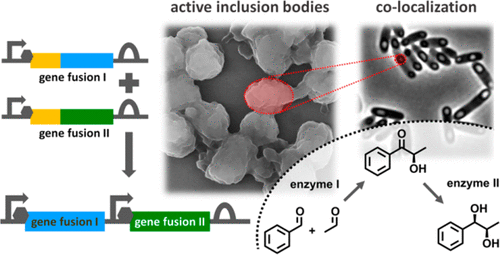当前位置:
X-MOL 学术
›
ACS Synth. Biol.
›
论文详情
Our official English website, www.x-mol.net, welcomes your
feedback! (Note: you will need to create a separate account there.)
A Synthetic Reaction Cascade Implemented by Colocalization of Two Proteins within Catalytically Active Inclusion Bodies
ACS Synthetic Biology ( IF 3.7 ) Pub Date : 2018-07-27 00:00:00 , DOI: 10.1021/acssynbio.8b00274 Vera D. Jäger 1, 2 , Robin Lamm 2, 3 , Ramona Kloß 2, 4 , Eugen Kaganovitch 4 , Alexander Grünberger 4, 5 , Martina Pohl 2, 4 , Jochen Büchs 2, 3 , Karl-Erich Jaeger 1, 2, 4 , Ulrich Krauss 1, 2
ACS Synthetic Biology ( IF 3.7 ) Pub Date : 2018-07-27 00:00:00 , DOI: 10.1021/acssynbio.8b00274 Vera D. Jäger 1, 2 , Robin Lamm 2, 3 , Ramona Kloß 2, 4 , Eugen Kaganovitch 4 , Alexander Grünberger 4, 5 , Martina Pohl 2, 4 , Jochen Büchs 2, 3 , Karl-Erich Jaeger 1, 2, 4 , Ulrich Krauss 1, 2
Affiliation

|
In nature, enzymatic reaction cascades, i.e., realized in metabolic networks, operate with unprecedented efficacy, with the reactions often being spatially and temporally orchestrated. The principle of “learning from nature” has in recent years inspired the setup of synthetic reaction cascades combining biocatalytic reaction steps to artificial cascades. Hereby, the spatial organization of multiple enzymes, e.g., by coimmobilization, remains a challenging task, as currently no generic principles are available that work for every enzyme. We here present a tunable, genetically programmed coimmobilization strategy that relies on the fusion of a coiled-coil domain as aggregation inducing-tag, resulting in the formation of catalytically active inclusion body coimmobilizates (Co-CatIBs). Coexpression and coimmobilization was proven using two fluorescent proteins, and the strategy was subsequently extended to two enzymes, which enabled the realization of an integrated enzymatic two-step cascade for the production of (1R,2R)-1-phenylpropane-1,2-diol (PPD), a precursor of the calicum channel blocker diltiazem. In particular, the easy production and preparation of Co-CatIBs, readily yielding a biologically produced enzyme immobilizate renders the here presented strategy an interesting alternative to existing cascade immobilization techniques.
中文翻译:

催化活性包涵体中两种蛋白质共定位实现的合成反应级联
在自然界中,酶促反应级联反应(即在代谢网络中实现的反应)具有空前的功效,并且反应通常在空间和时间上进行协调。近年来,“向自然学习”的原则启发了建立将生物催化反应步骤与人工级联相结合的合成反应级联的方法。因此,多种酶的空间组织,例如通过共固定化,仍然是一项艰巨的任务,因为目前尚无适用于每种酶的通用原理。我们在这里提出了一种可调的,遗传程序控制的固定化策略,该策略依靠卷曲螺旋结构域的融合作为聚集诱导标签,从而导致催化活性的包涵体共固定化(Co-CatIBs)的形成。使用两种荧光蛋白证明了共表达和共固定化,随后将该策略扩展到了两种酶,从而实现了用于生产(1 R,2 R)-1-苯基丙烷-1,2-二醇(PPD),笛卡尔通道阻滞剂地尔硫卓的前体。特别地,容易产生和制备Co-CatIBs,容易产生生物产生的酶固定化产物,使得本文提出的策略成为现有的级联固定化技术的有趣替代。
更新日期:2018-07-27
中文翻译:

催化活性包涵体中两种蛋白质共定位实现的合成反应级联
在自然界中,酶促反应级联反应(即在代谢网络中实现的反应)具有空前的功效,并且反应通常在空间和时间上进行协调。近年来,“向自然学习”的原则启发了建立将生物催化反应步骤与人工级联相结合的合成反应级联的方法。因此,多种酶的空间组织,例如通过共固定化,仍然是一项艰巨的任务,因为目前尚无适用于每种酶的通用原理。我们在这里提出了一种可调的,遗传程序控制的固定化策略,该策略依靠卷曲螺旋结构域的融合作为聚集诱导标签,从而导致催化活性的包涵体共固定化(Co-CatIBs)的形成。使用两种荧光蛋白证明了共表达和共固定化,随后将该策略扩展到了两种酶,从而实现了用于生产(1 R,2 R)-1-苯基丙烷-1,2-二醇(PPD),笛卡尔通道阻滞剂地尔硫卓的前体。特别地,容易产生和制备Co-CatIBs,容易产生生物产生的酶固定化产物,使得本文提出的策略成为现有的级联固定化技术的有趣替代。











































 京公网安备 11010802027423号
京公网安备 11010802027423号